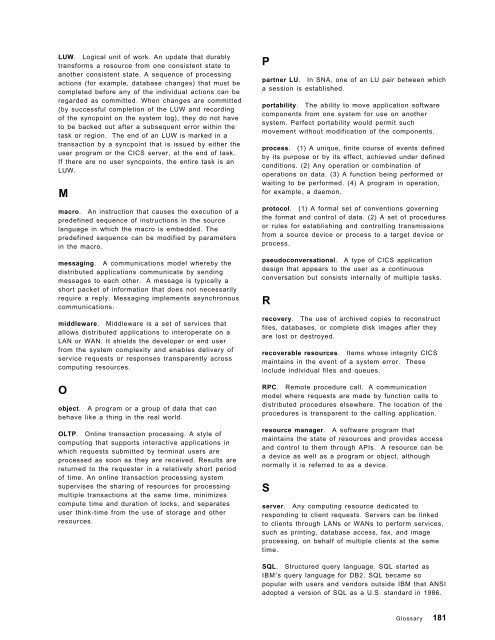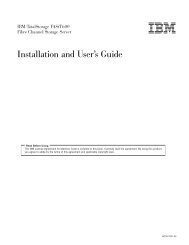Addressing OLTP Solutions with CICS: The Transaction Server ... - Ibm
Addressing OLTP Solutions with CICS: The Transaction Server ... - Ibm
Addressing OLTP Solutions with CICS: The Transaction Server ... - Ibm
Create successful ePaper yourself
Turn your PDF publications into a flip-book with our unique Google optimized e-Paper software.
LUW. Logical unit of work. An update that durably<br />
transforms a resource from one consistent state to<br />
another consistent state. A sequence of processing<br />
actions (for example, database changes) that must be<br />
completed before any of the individual actions can be<br />
regarded as committed. When changes are committed<br />
(by successful completion of the LUW and recording<br />
of the syncpoint on the system log), they do not have<br />
to be backed out after a subsequent error <strong>with</strong>in the<br />
task or region. <strong>The</strong> end of an LUW is marked in a<br />
transaction by a syncpoint that is issued by either the<br />
user program or the <strong>CICS</strong> server, at the end of task.<br />
If there are no user syncpoints, the entire task is an<br />
LUW.<br />
M<br />
macro. An instruction that causes the execution of a<br />
predefined sequence of instructions in the source<br />
language in which the macro is embedded. <strong>The</strong><br />
predefined sequence can be modified by parameters<br />
in the macro.<br />
messaging. A communications model whereby the<br />
distributed applications communicate by sending<br />
messages to each other. A message is typically a<br />
short packet of information that does not necessarily<br />
require a reply. Messaging implements asynchronous<br />
communications.<br />
middleware. Middleware is a set of services that<br />
allows distributed applications to interoperate on a<br />
LAN or WAN. It shields the developer or end user<br />
from the system complexity and enables delivery of<br />
service requests or responses transparently across<br />
computing resources.<br />
O<br />
object. A program or a group of data that can<br />
behave like a thing in the real world.<br />
<strong>OLTP</strong>. Online transaction processing. A style of<br />
computing that supports interactive applications in<br />
which requests submitted by terminal users are<br />
processed as soon as they are received. Results are<br />
returned to the requester in a relatively short period<br />
of time. An online transaction processing system<br />
supervises the sharing of resources for processing<br />
multiple transactions at the same time, minimizes<br />
compute time and duration of locks, and separates<br />
user think-time from the use of storage and other<br />
resources.<br />
P<br />
partner LU. In SNA, one of an LU pair between which<br />
a session is established.<br />
portability. <strong>The</strong> ability to move application software<br />
components from one system for use on another<br />
system. Perfect portability would permit such<br />
movement <strong>with</strong>out modification of the components.<br />
process. (1) A unique, finite course of events defined<br />
by its purpose or by its effect, achieved under defined<br />
conditions. (2) Any operation or combination of<br />
operations on data. (3) A function being performed or<br />
waiting to be performed. (4) A program in operation,<br />
for example, a daemon.<br />
protocol. (1) A formal set of conventions governing<br />
the format and control of data. (2) A set of procedures<br />
or rules for establishing and controlling transmissions<br />
from a source device or process to a target device or<br />
process.<br />
pseudoconversational. A type of <strong>CICS</strong> application<br />
design that appears to the user as a continuous<br />
conversation but consists internally of multiple tasks.<br />
R<br />
recovery. <strong>The</strong> use of archived copies to reconstruct<br />
files, databases, or complete disk images after they<br />
are lost or destroyed.<br />
recoverable resources. Items whose integrity <strong>CICS</strong><br />
maintains in the event of a system error. <strong>The</strong>se<br />
include individual files and queues.<br />
RPC. Remote procedure call. A communication<br />
model where requests are made by function calls to<br />
distributed procedures elsewhere. <strong>The</strong> location of the<br />
procedures is transparent to the calling application.<br />
resource manager. A software program that<br />
maintains the state of resources and provides access<br />
and control to them through APIs. A resource can be<br />
a device as well as a program or object, although<br />
normally it is referred to as a device.<br />
S<br />
server. Any computing resource dedicated to<br />
responding to client requests. <strong>Server</strong>s can be linked<br />
to clients through LANs or WANs to perform services,<br />
such as printing, database access, fax, and image<br />
processing, on behalf of multiple clients at the same<br />
time.<br />
SQL. Structured query language. SQL started as<br />
IBM′s query language for DB2. SQL became so<br />
popular <strong>with</strong> users and vendors outside IBM that ANSI<br />
adopted a version of SQL as a U.S. standard in 1986.<br />
Glossary 181
















